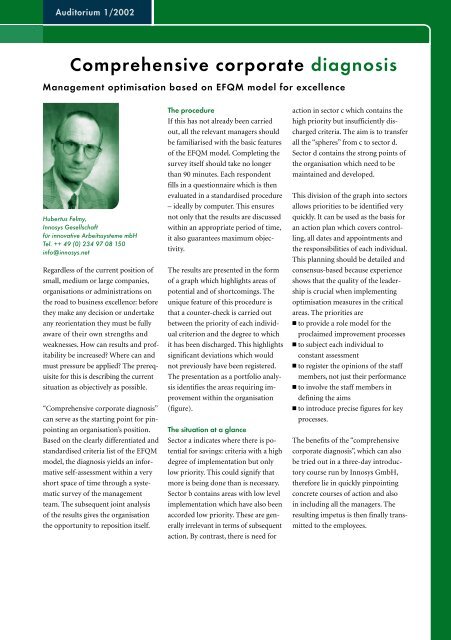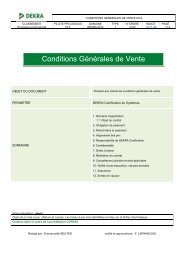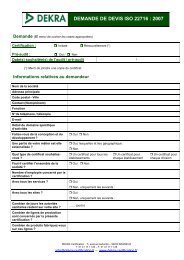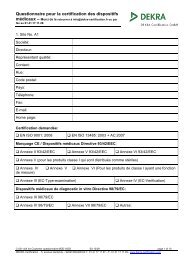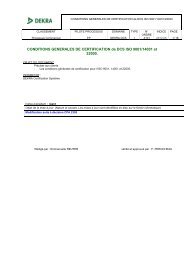DEKRA Award 2001 - DEKRA Certification
DEKRA Award 2001 - DEKRA Certification
DEKRA Award 2001 - DEKRA Certification
Sie wollen auch ein ePaper? Erhöhen Sie die Reichweite Ihrer Titel.
YUMPU macht aus Druck-PDFs automatisch weboptimierte ePaper, die Google liebt.
Auditorium 1/2002<br />
Comprehensive corporate diagnosis<br />
Management optimisation based on EFQM model for excellence<br />
Hubertus Felmy,<br />
Innosys Gesellschaft<br />
für innovative Arbeitssysteme mbH<br />
Tel. ++ 49 (0) 234 97 08 150<br />
info@innosys.net<br />
Regardless of the current position of<br />
small, medium or large companies,<br />
organisations or administrations on<br />
the road to business excellence: before<br />
they make any decision or undertake<br />
any reorientation they must be fully<br />
aware of their own strengths and<br />
weaknesses. How can results and profitability<br />
be increased? Where can and<br />
must pressure be applied? The prerequisite<br />
for this is describing the current<br />
situation as objectively as possible.<br />
“Comprehensive corporate diagnosis”<br />
can serve as the starting point for pinpointing<br />
an organisation’s position.<br />
Based on the clearly differentiated and<br />
standardised criteria list of the EFQM<br />
model, the diagnosis yields an informative<br />
self-assessment within a very<br />
short space of time through a systematic<br />
survey of the management<br />
team. The subsequent joint analysis<br />
of the results gives the organisation<br />
the opportunity to reposition itself.<br />
The procedure<br />
If this has not already been carried<br />
out, all the relevant managers should<br />
be familiarised with the basic features<br />
of the EFQM model. Completing the<br />
survey itself should take no longer<br />
than 90 minutes. Each respondent<br />
fills in a questionnaire which is then<br />
evaluated in a standardised procedure<br />
– ideally by computer. This ensures<br />
not only that the results are discussed<br />
within an appropriate period of time,<br />
it also guarantees maximum objectivity.<br />
The results are presented in the form<br />
of a graph which highlights areas of<br />
potential and of shortcomings. The<br />
unique feature of this procedure is<br />
that a counter-check is carried out<br />
between the priority of each individual<br />
criterion and the degree to which<br />
it has been discharged. This highlights<br />
significant deviations which would<br />
not previously have been registered.<br />
The presentation as a portfolio analysis<br />
identifies the areas requiring improvement<br />
within the organisation<br />
(figure).<br />
The situation at a glance<br />
Sector a indicates where there is potential<br />
for savings: criteria with a high<br />
degree of implementation but only<br />
low priority. This could signify that<br />
more is being done than is necessary.<br />
Sector b contains areas with low level<br />
implementation which have also been<br />
accorded low priority. These are generally<br />
irrelevant in terms of subsequent<br />
action. By contrast, there is need for<br />
action in sector c which contains the<br />
high priority but insufficiently discharged<br />
criteria. The aim is to transfer<br />
all the “spheres” from c to sector d.<br />
Sector d contains the strong points of<br />
the organisation which need to be<br />
maintained and developed.<br />
This division of the graph into sectors<br />
allows priorities to be identified very<br />
quickly. It can be used as the basis for<br />
an action plan which covers controlling,<br />
all dates and appointments and<br />
the responsibilities of each individual.<br />
This planning should be detailed and<br />
consensus-based because experience<br />
shows that the quality of the leadership<br />
is crucial when implementing<br />
optimisation measures in the critical<br />
areas. The priorities are<br />
to provide a role model for the<br />
proclaimed improvement processes<br />
to subject each individual to<br />
constant assessment<br />
to register the opinions of the staff<br />
members, not just their performance<br />
to involve the staff members in<br />
defining the aims<br />
to introduce precise figures for key<br />
processes.<br />
The benefits of the “comprehensive<br />
corporate diagnosis”, which can also<br />
be tried out in a three-day introductory<br />
course run by Innosys GmbH,<br />
therefore lie in quickly pinpointing<br />
concrete courses of action and also<br />
in including all the managers. The<br />
resulting impetus is then finally transmitted<br />
to the employees.


